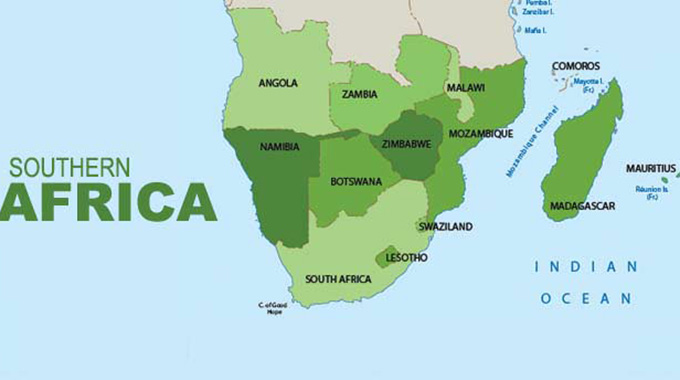Southern Africa: Tropical storms a major concern

Sifelani Tsiko
Agric, Environment & Innovations Editor
Cyclone Freddy, widely seen by climate experts as one of the long lasting weather systems to ever affect the southern hemisphere since 2000, tore through some parts of southern Africa, wreaking havoc and raising fresh fears of the growing number of weather-related natural disasters in the region.
Tropical cyclone scientists at the United Nations weather agency for the Indian Ocean sub-continent say Freddy travelled more than 9 000km across the southern Indian Ocean and made landfalls in Madagascar and Mozambique at the end of February.
And, nearly a month after its formation off the coast of southern Indonesia, Freddy is still active in the Mozambique Channel having survived the land barrier interface in Mozambique.
It has managed to loop back eastward and re-emerged over the Mozambique Channel between southern Africa and Madagascar, where it has become a tropical cyclone once again.
Meteorological experts say this is the first time since year 2000 that a cyclone has moved such a long distance from the south-eastern parts to the south-western parts of the Indian Ocean.
They suggest that it is highly unusual for cyclones to be sustained for such long periods and travel such long distances.
Freddy is only one of four tropical cyclones on record that have travelled across the entire southern Indian Ocean, according to National Oceanic and Atmospheric Administration (NOAA) records.
It peaked its intensity from February 18 to 19 – only the 20th tropical cyclone to do so in the South Indian Ocean since 1989, NOAA experts say.
According to the UN Office for the co-ordination of humanitarian Affairs, cyclone Freddy left four people dead in Madagascar leaving over 3 100 people displaced and more than 3 300 houses flooded as at March 6 reports.
The cyclone crashed ashore in Madagascar on February 21 and continued westward and made landfall in Mozambique on February 24, nearly 166 600 people were affected leaving 9 900 displaced, 28 300 houses, 25 health-care facilities and 919 classrooms destroyed.
More than 38 100 hectares of crops were affected.
Freddy’s death toll is now at least 21 people (10 in Mozambique and 11 in Madagascar).
This tropical cyclone started on February 6 off the coast of southern Indonesia and is fast approaching the record for the longest-lasting tropical cyclone on Earth, which currently stands at 31 days set by Hurricane/Typhoon John in the Pacific Ocean in 1994.
Freddy came after tropical cyclone Cheneso formed over the south-western Indian Ocean affected Madagascar and Mozambique in January this year.
This cyclone quickly dissipated without leaving much damage compared to cyclone Freddy.
Southern African countries that include Zimbabwe, Mozambique, Malawi, Madagascar, Mauritius and other small island nations located in the Indian Ocean are no strangers to tropical cyclones.
Climate change impacts are increasingly being felt more in this region endangering millions of people.
The countries have suffered severe flooding after a series of tropical storms, including three cyclones that hit the region, starting with storms Ana and Batsirai in January and February 2022.
The tropical storms brought winds, heavy rains, damage and destruction to some of these countries now prone to the impacts of cyclones that batter the region.
Tropical storms have caused severe humanitarian impacts in Madagascar, Mozambique, Malawi and Zimbabwe including deaths and injuries, infrastructure damage and a range of long-lasting socio-economic impacts.
Southern Africa now experiences about 10 storms or cyclones which travel across the south – western Indian Ocean every year during the rainfall season that runs from October to April.
Tropical storms have destroyed homes, crops, bridges and roads bringing untold hardships to the affected communities.
In some cases, tropical storms have cut electricity supplies causing blackouts in some countries in southern Africa.
In the three affected countries, the tropical storms have cut vital road links and electricity supply lines, shaking the economies of these countries.
The recovery processes have not been easy in most of the countries, with some still reeling from the impact of cyclone Eline of the 1999 – 2000 rainfall season.
The Cyclone Eline-induced floods in the 1999-2000 season claimed the lives of more than 700 people and left more than 500 000 people homeless and caused infrastructural damage in Zimbabwe and Mozambique, according to a ReliefWeb report in 2001.
Cyclone Eline destroyed homes, schools, clinics, dams burst while crops and vital infrastructure were damaged.
Lots of people were killed and as the impact of floods worsened up to two million people were displaced.
The cyclone which struck southern Africa, caught most people in the region totally unprepared, flooding entire villages, damaging livestock, crops and infrastructure.
The most damaging tropical cyclones of the past few years were tropical cyclones Idai and Kenneth, which hit Mozambique especially hard in March and April of 2019.
Tropical Cyclone Idai, the worst in more than 50 years, brought heavy rainfall and strong winds to Malawi, Mozambique and Zimbabwe between March 5 and 19 2019, causing severe flooding which led to loss of lives, destruction of infrastructure, disruption of livelihoods and destruction of crops.
Idai alone killed more than 1 500 people in Mozambique, Malawi and Zimbabwe.
Southern Africa has also not been spared from weather-related disasters.
The region is now experiencing an average or above-average number of tropical cyclones every season.
In 2021, cyclones Eloise and Chalane battered Zimbabwe, Mozambique and Botswana leaving scores of people dead, crops and infrastructural damage running into thousands of dollars.
A year on, in 2022, tropical storm Ana caused widespread damage in Madagascar, Mozambique and Malawi killing 88 people.
Meteorological researchers say at least 30 tropical cyclones have affected the Southern African region since the 1800s.
In the 1900s, major tropical storms that struck the region occurred in 1950 when after crossing Madagascar, a cyclone barrelled through Mozambique and reached northern Namibia while in April 1952 another hit south-eastern Tanzania with sustained winds of 180 km/h — the strongest on record to strike the country left 34 people dead.
On January 28, 1984, tropical storm Domoina struck south – eastern Mozambique before crossing into Swaziland and eastern South Africa.
It killed 109 people and caused about $75 million in damage in Mozambique while in Swaziland it killed 73 people with damages estimated at US$54 million and in South Africa the storm killed 60 people and damaged the properties of 500 000 people worth US$70 million.
In that year, in February, tropical Storm Imboa reportedly looped off the east coast of South Africa, causing flooding and killing four people in the country.
Cyclone Bonita also made headlines in 1996 when it hit the region destroying houses, crops and livestock.
Human lives were also lost.
Cyclone Bonita came through the northern Mazowe/Makonde areas and resulted in floods in the Muzarabani area bordering Zambia and Mozambique.
Beyond 1996, the region also experienced more floods.
In the year 2000, the region was hit by tropical storms Astride (Jan 3, 2000), Cyclone Eline (Feb 22, 2000), Gloria (March 8, 2000), Hudah (Apr 2, 2000) and a sub–tropical depression on April 11.
In years that followed tropical storms that battered the region included: Cyprien (Dec 30, 2001), Delfina (Dec 31, 2002 — killed 47 people in Mozambique and 8 in Malawi), Japhet (March 2, 2003 — killed 17 in Mozambique, 8 in Zambia), Elita (Jan 26, 2004), Tropical disturbance (Oct 29, 2004), Anita (Nov 30, 2006), Favio (Feb 22, 2007), Elnus (Dec 29, 2007), Jokwe (March 8, 2008), Asma (Oct 24, 2008) and Izilda (March 27, 2009).
From 2010, cyclones that tore through the southern Africa region included — Dando (Jan 17, 2012 -killed four people in Mozambique and another six in South Africa), Funso (Jan 21, 2012 — killed 21 people in Mozambique), Irina (March 6, 2012 — killed 12 in Mozambique and South Africa), Haruna (Feb 16, 2013), Deliwe (Jan 20, 2014), tropical disturbance (Jan 31, 2014), Guito (Feb 17, 2014), Hellen (March 26, 2014 — killed 4 in Mozambique), Chedza (Jan 14, 2015), Fantala (April 27, 2016 — killed 13 in Tanzania, destroyed 315 houses), Dineo (Feb 15, 2017 — Cyclone Dineo killed seven people in Mozambique and 251 people in Zimbabwe), tropical depression (Jan 15, 2018 — killed 11 in Mozambique), Tropical storm Desmond (Jan 17, 2019), Idai (March 4, 2019 — killed 1 500 in region) and Kenneth (April 25, 2019 — killed 45 people in Mozambique).
In the 2020s, cyclones that hammered southern Africa included – Chalane (Dec 30, 2020), Eloise (Jan 22, 2021 – killed 11 in Mozambique, 10 in South Africa, 3 in Zimbabwe and 2 in eSwatini), Guambe (Feb 12, 2021), Jobo (April 24, 2021 – killed 22 people in Tanzania), Ana (Jan 24, 2022 – killed 20 in Mozambique and 37 in Malawi), Dumako (Feb 18, 2022), Gombe (March 11, 2022 – killed 63 people in Mozambique and 7 in Malawi) and sub-tropical depression Issa (April 12, 2022 – caused floods, killed 259 people in South Africa).
Africa has incurred economic losses of up to US$5 billion due to weather-related disasters that have hit the continent and other parts of the world over the past five decades, according to a World Meteorological Organisation report released in 2021.
According to the WMO Atlas of Mortality and Economic Losses from Weather, Climate and Water Extremes (1970-2019), Africa recorded 1 695 disasters that caused the loss of 731 747 lives and $5 billion in economic losses.
The continent accounts for 15 percent of weather, climate, and water-related disasters, 35 percent of associated deaths and one percent of economic losses reported globally.
Although disasters associated with floods were the most prevalent at 60 percent, droughts led to the highest number of deaths, accounting for 95 per cent of all lives lost in the region, with most occurring in Ethiopia, Mozambique and Sudan.
WMO report said over the past 50 years, disasters related to weather, climate or water hazards have become a regular occurrence, responsible for the deaths of at least 115 people, and causing $202 million in economic losses every day.
The report noted that the number of weather-related disasters to hit the world has increased five-fold over the past 50 years even though the number of deaths due to storms, floods and droughts has declined sharply.
Despite having improved on disaster preparedness since tropical storm Idai, most southern African countries prone to storms still lack the capacity to respond timeously to catastrophes despite the existence of units of disaster management.
Some of the major hurdles included financial constraints, disjointed responses, poor planning, lack of emergency relief items and communication equipment to broadcast timely information of developing events such as storms to rural communities.
Lack of rescue equipment, bureaucracy, lack of data and community resistance for some communities to be moved to higher ground and lack of political will to finance disaster units still affect the disaster preparedness of most countries in the region.
Storms affecting the region highlighted the need for investment to mitigate against climate change.
During the rainy and cyclonic season, more people are becoming vulnerable as the cycle of extremely heavy destructive rains and cyclones intensify.
The season is yet to end and cyclone Freddy is active and still poses a serious risk of heavy rainfall to Madagascar, Mozambique, Malawi, Zambia and Zimbabwe.








Comments